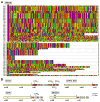Bacterial contact-dependent growth inhibition
- PMID: 23473845
- PMCID: PMC3648609
- DOI: 10.1016/j.tim.2013.02.003
Bacterial contact-dependent growth inhibition
Abstract
Bacteria cooperate to form multicellular communities and compete against one another for environmental resources. Here, we review recent advances in the understanding of bacterial competition mediated by contact-dependent growth inhibition (CDI) systems. Different CDI+ bacteria deploy a variety of toxins to inhibit neighboring cells and protect themselves from autoinhibition by producing specific immunity proteins. The genes encoding CDI toxin-immunity protein pairs appear to be exchanged between cdi loci and are often associated with other toxin-delivery systems in diverse bacterial species. CDI also appears to facilitate cooperative behavior between kin, suggesting that these systems may have other roles beyond competition.
Copyright © 2013 Elsevier Ltd. All rights reserved.
Figures




References
Publication types
MeSH terms
Substances
Grants and funding
LinkOut - more resources
Full Text Sources
Other Literature Sources

